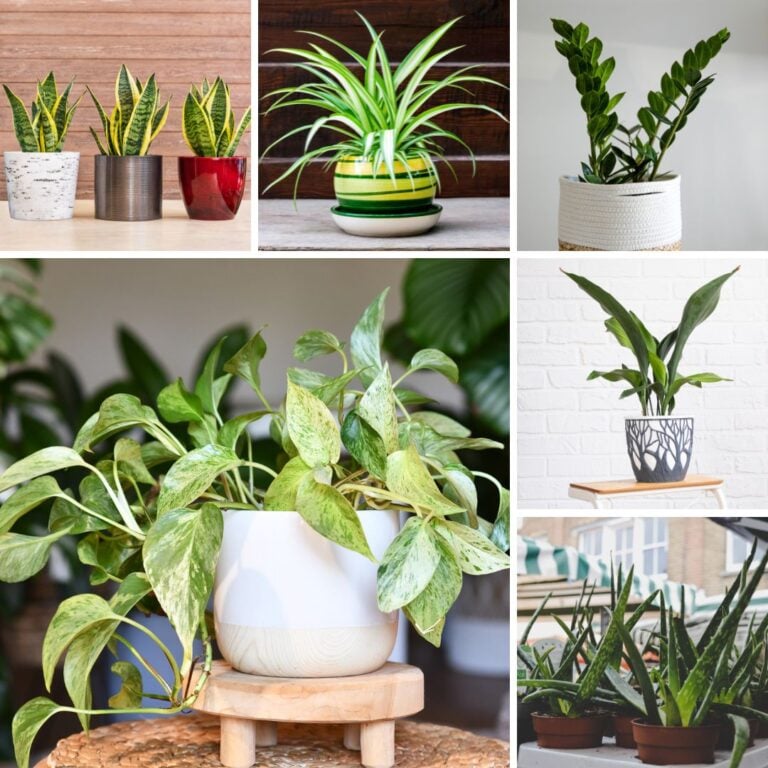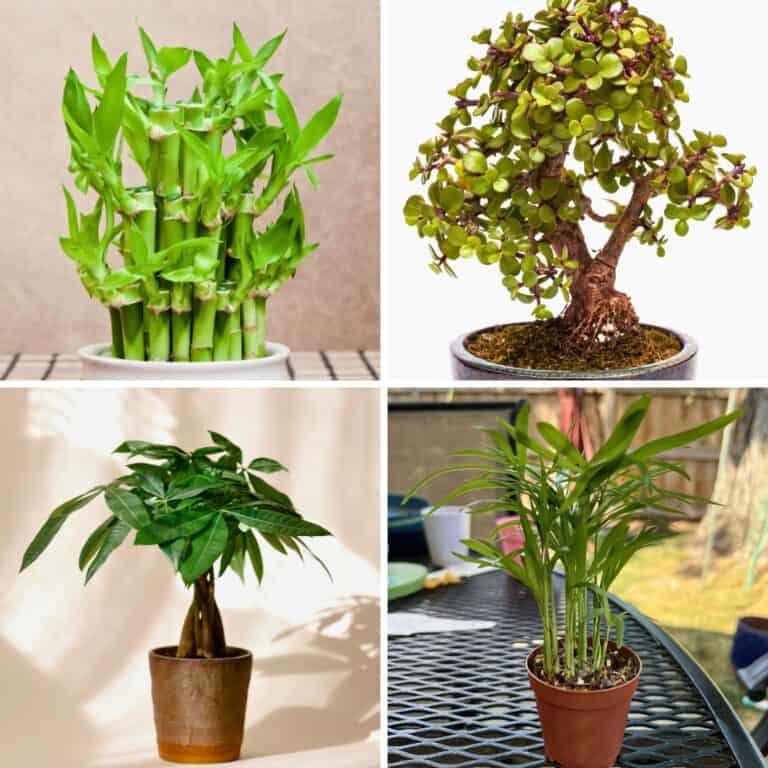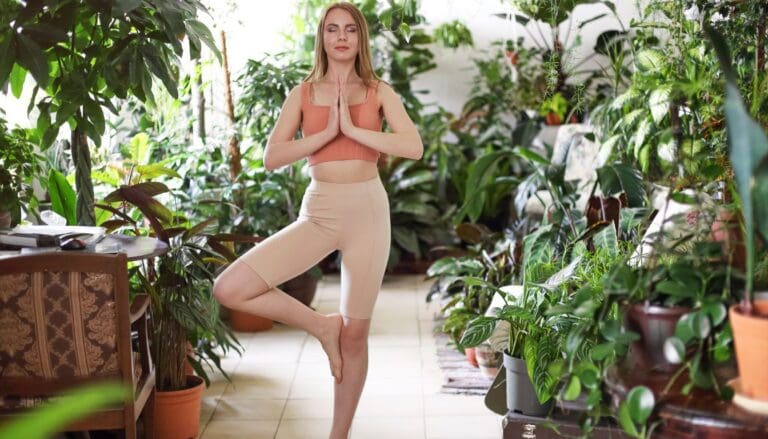8 Best Indoor Trailing Plants to Transform Your Space
Looking to add a touch of greenery to your home? Indoor trailing plants might be just what you need!
These plants can drape beautifully from shelves, hanging pots, or even bookcases, bringing a bit of nature indoors.
The great thing about trailing plants is that they’re relatively easy to care for, making them perfect even for beginners.
From enhancing your décor to improving air quality, these plants have multiple benefits.
What’s your favorite spot to showcase them? 🌿💕
Please note: Simplify Plants is reader-supported. As an Amazon Associate, I earn from qualifying purchases made by our readers with no extra cost added to you all! Some links in the post are affiliate links and I get a commission from purchases made through links in the post.
1) Philodendron Brasil

Let me introduce you to one of my all-time faves: Philodendron Brasil.
This trailing plant is an absolute delight. It’s perfect for adding some greenery to your indoor space, and trust me, it’s super easy to care for! 🌿
The Philodendron Brasil has unique heart-shaped leaves with stunning shades of green and yellow.
It’s like bringing a mini jungle right into your home. Plus, its trailing vines can create such a cozy and vibrant atmosphere.
I love placing mine on a high shelf or in a hanging planter.
When it comes to light, this beauty loves bright, indirect light.
But don’t worry if you don’t have that; it can adapt to lower light conditions too. Just make sure to avoid direct sunlight, which can damage its leaves.
Let’s talk soil. This plant thrives in well-draining, slightly acidic soil.
You can make your own mix of half potting soil and half coco fiber, peat moss, or even orchid bark for best results. 🌱
Watering is pretty straightforward. Keep the soil moist but not soggy. The key is moderation—water it regularly but let it dry out a bit between watering. Overwatering can be a sneaky plant killer!
Thinking about pruning? Have no fear!
Grab a pair of clean scissors and cut back a few inches above a node. This helps keep the plant compact and bushy. For even longer vines, remove any underperforming stems.
Temperature-wise, aim for 60°F to 75°F.
These plants can handle a bit of a chill but try to keep them away from frosty windows or drafty spots. ❄️
I also give mine a little boost with monthly fertilization during the growing season in spring and summer.
It’s like giving your plant a yummy treat to help it grow big and strong!
2) Spider Plant
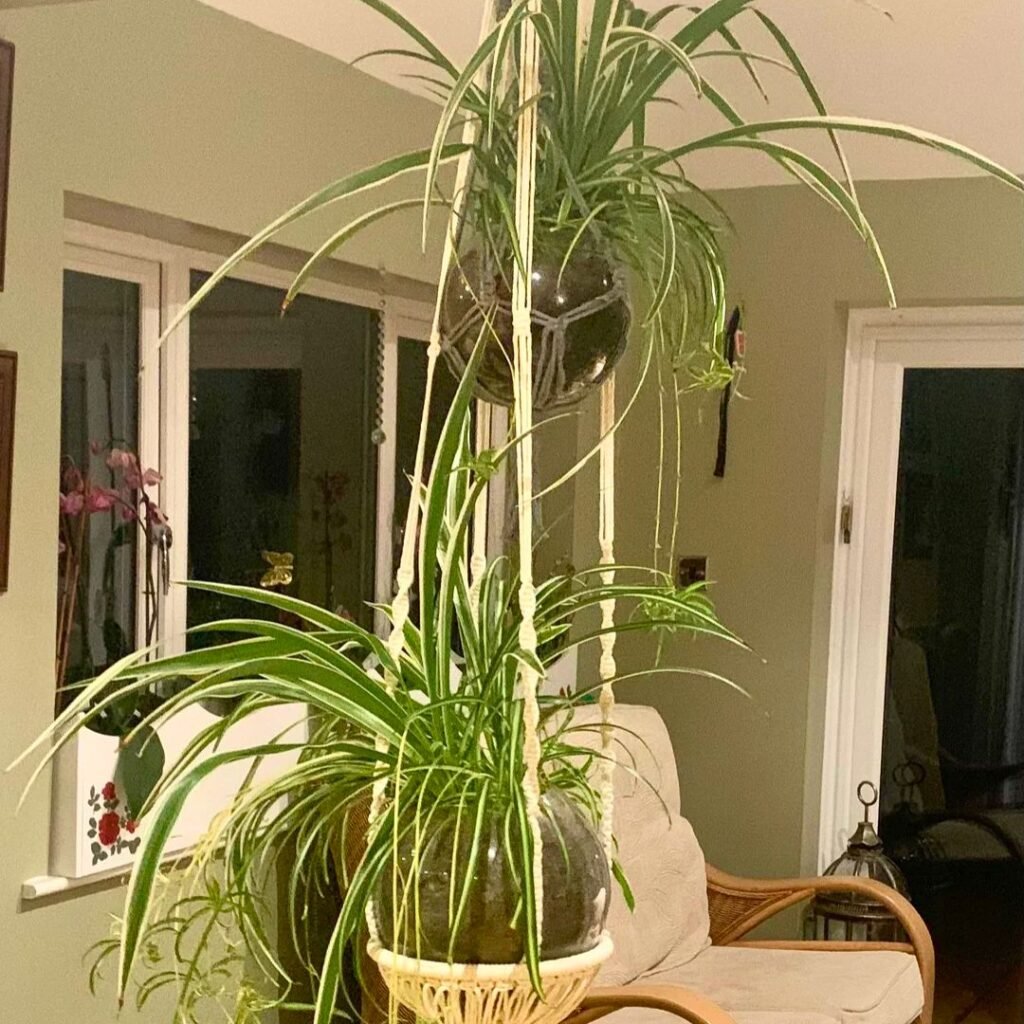
The Spider Plant is a superhero among indoor plants. 🌿 It’s not only beautiful but also super easy to care for.
I remember getting my first Spider Plant and being amazed at how quickly it grew!
One of the coolest things about Spider Plants is their ability to produce baby plantlets. These little plantlets dangle from the mother plant like spiders on a web. It’s easy to see how they got their name!
Spider Plants love indirect light, so placing them near a window but out of direct sun is ideal.
They can get by with low light too, which makes them perfect for just about any space in your home.
Watering them is a breeze. Just make sure the soil stays slightly moist.
I usually water mine once a week, and it thrives. If you forget to water it for a while, don’t worry—they’re pretty forgiving.
Spider Plants can grow in pots or hanging baskets.
I like to put mine in a hanging basket so the plantlets have room to cascade down. They create such a lush, green curtain!
They don’t just look good—they’re also great for air quality.
Spider Plants can help remove common pollutants from the air, making your home healthier.
Got pets? No problem! Spider Plants are non-toxic to cats and dogs, so your furry friends can stay safe even if they decide to take a nibble.
3) English Ivy

English Ivy is a classic choice for indoor trailing plants. I love its fast-growing nature and how it brings a touch of the outdoors inside. 🌿
English Ivy thrives in indirect, moderate sunlight.
I place mine near a window where it gets plenty of light but not too much direct sun. Too much direct sunlight can cause its leaves to burn.
One thing I’ve noticed is that English Ivy prefers cooler rooms.
Keeping it at temperatures between 50-75°F (10-24°C) works best. It also loves high humidity, so I sometimes use a pebble tray with water underneath or a humidifier nearby.
Regular trimming is crucial to keep the plant manageable and looking its best.
This plant can grow quite long, sometimes reaching 20-40 feet in length! Don’t worry, a pair of scissors and a little patience will do the trick.
Feeding your English Ivy is also important.
I use a balanced 20-20-20 fertilizer every two weeks during the growing season (spring and summer).
Just be sure not to fertilize if the plant is stressed, like during very hot or cold spells.
Do you have English Ivy at home? How do you care for yours? Let me know in the comments! 💬
4) String of Pearls
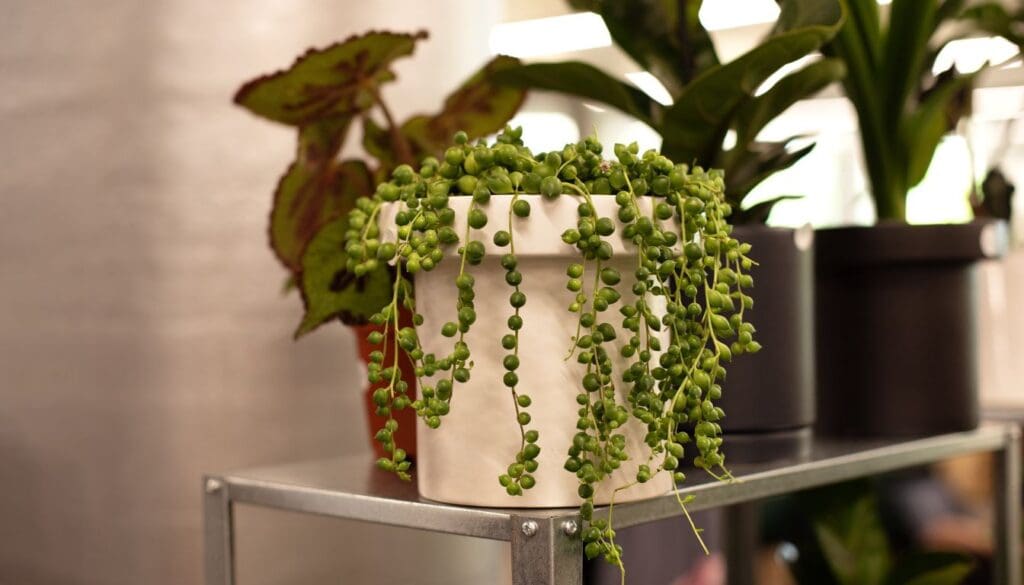
String of Pearls is one of my absolute favorite indoor trailing plants. 🌿
This plant is known for its unique, bead-like leaves that drape elegantly over the sides of pots. It’s a real showstopper! Plus, it’s super easy to care for, making it perfect for beginners.
This plant is a succulent, which means it doesn’t need a lot of water. In fact, overwatering is a big no-no.
I water my String of Pearls once every couple of weeks, and it thrives! Just make sure to let the soil dry out completely between waterings.
When it comes to soil, I use a cactus and succulent mix.
This type of soil helps with drainage, which is crucial for preventing root rot. You can find it at most garden stores, or even mix your own at home using sand and regular potting soil.
One of the coolest things about String of Pearls is how easy it is to propagate. 🌱
Just take a cutting, let it dry for a day, and then plant it in soil. Before you know it, you’ll have baby pearls growing into a new plant!
String of Pearls also loves bright, indirect light.
Place it near a window where it can get lots of light, but not direct sun, which can scorch its leaves. If you notice the pearls looking a bit shriveled, they might need more light.
I also like to use a balanced fertilizer during the growing season.
Something like a 10-10-10 mix works well. In the colder months, you can cut back on fertilizing to once every six weeks or so.
Do you have a String of Pearls? Or are you thinking about getting one? 🪴 Share your thoughts and experiences in the comments below! I’d love to hear from you.
5) Pothos

Pothos is one of my favorite indoor trailing plants. It’s super low-maintenance and perfect for beginners. 🌿
This plant can thrive in various light conditions, but it does best in bright, indirect light. If you place it near a window, you’ll see those leaves shine!
Do you love plants but aren’t great at keeping them alive? Pothos is your new best friend.
It can tolerate occasional neglect, so if you forget to water it once in a while, it won’t hold a grudge.
One cool thing about Pothos is its variegated leaves.
Some types, like the Golden Pothos, have beautiful yellow and green patterns.
Imagine this beauty trailing down from a shelf or hanging basket. It’s an instant room enhancer! 🏡
How long will it get? Well, if you let it, Pothos can grow up to 10 feet long.
Perfect for filling up that empty wall space with some natural greenery.
Do you have pets? No worries!
Just make sure your Pothos stays out of their reach because it’s toxic if ingested. Better safe than sorry!
I love how versatile Pothos is.
You can grow it up a moss pole, let it trail from a high shelf, or even train it along a window sill for a natural green curtain.
Have you ever tried growing Pothos? Share your thoughts and experiences in the comments! I’d love to hear how you style your plant babies. 🌱✨
6) Burro’s Tail

Burro’s Tail, also known as Sedum morganianum, is one of my favorite indoor trailing plants. It’s known for its long, trailing stems and fleshy, blue-green leaves that look like a donkey’s tail.
Perfect for hanging baskets, it adds a lovely touch to any room. 🌿
This plant loves bright, indirect light. Too much direct sunlight can cause the leaves to scorch.
I keep mine near a sunny window but out of the harsh rays. If your Burro’s Tail starts looking a bit pale, it might need more light!
Watering is straightforward but needs some attention. This succulent stores water in its leaves, so over-watering can lead to rot.
I water mine every couple of weeks, allowing the soil to dry between waterings. Remember, less is more when it comes to succulents!
Propagating Burro’s Tail is super easy and a fun project. You can use stem cuttings or even just leaves.
Place them on top of well-draining soil and keep them in a bright spot. They’ll soon sprout roots and start growing! 🌱
Temperature-wise, Burro’s Tail thrives between 65-75°F (18-24°C). It can handle a bit cooler or warmer for short periods, but extremes can stress the plant.
Keep it cozy, and it’ll keep looking gorgeous.
7) Creeping Fig

Creeping Fig is one of my favorite indoor trailing plants. 🌿 It’s also known as Ficus pumila and it’s perfect if you want a plant that can both trail and climb. I love how versatile it is!
It grows well in temperatures between 55-75°F (13-24°C). Keep it away from direct sunlight, but place it in a brightly lit area.
It’s great that it can also tolerate low light conditions, which makes it perfect for almost any room.
One thing to keep in mind is to keep the plant’s roots moist. I water mine about once a week. 💧 If you forget to water it now and then, don’t worry, it’s quite hardy.
Humidity is also important for Creeping Fig. If your home is on the dry side, you might want to mist it occasionally.
Or, you can place it in a bathroom or kitchen where there’s more moisture.
8) String of Hearts

String of Hearts is one of my favorite indoor trailing plants. 🌿 Its heart-shaped leaves dangle gracefully, making any room feel cozier. The leaves come in shades of green, cream, and even pink, which adds a splash of color to your home.
This plant loves bright, indirect light. I keep mine near a window where it gets lots of natural light without the direct sun.
It’s not a fan of extreme sunlight, which can lead to leaf burn.
Watering is a breeze if you follow a simple schedule. 💦 I water my String of Hearts every 1.5 to 2 weeks.
It’s important to let the soil completely dry out between waterings to avoid root rot. Overwatering is a no-no!
I use a balanced houseplant fertilizer once or twice a year, usually in the spring and summer.
This gives the plant a little boost to keep those leaves looking vibrant and healthy.
One thing I love about the String of Hearts is its ability to grow quite long. It can reach up to 12 feet outdoors, but indoors, it usually stays around 3-4 feet.
Perfect for hanging baskets or shelves! 🪴
Repotting is simple. You can repot every year or 18 months. Choose a pot that’s 1-2 inches bigger in diameter than the current one, and refresh the soil.
FAQs
How much light do trailing plants need?
Most trailing plants thrive in bright, indirect light. Some can tolerate low light, but they might not grow as quickly.
If your plant isn’t trailing much, it might need more light. 🌞
How often should I water my trailing plants?
It really depends on the plant. In general, I water mine when the top inch of soil feels dry.
Overwatering can lead to root rot, so it’s better to let them dry out a bit between waterings.
What’s the best way to encourage trailing?
To encourage trailing, you can prune the tips of the plant. This helps promote new growth and makes the plant bushier.
Also, make sure they’re getting enough light and nutrients.
Are trailing plants safe for pets?
Some trailing plants are toxic to pets. For example, Pothos and Philodendrons should be kept out of reach of cats and dogs.
Always check if the plant is pet-friendly before bringing it home.
Can I grow trailing plants from cuttings?
Absolutely! Trailing plants like the String-of-Hearts and Pothos are easy to propagate.
Just cut a healthy stem, put it in water until roots develop, then plant it in soil. Super fun and satisfying! 🌱
Why are the leaves of my trailing plant turning yellow?
Yellow leaves can be a sign of overwatering, lack of light, or nutrients. Check your plant care routine and adjust as needed.
Sometimes, it’s just a natural part of the plant’s cycle.
How do I deal with pests on my trailing plants?
Pests like spider mites can be annoying. I use a mix of water and a bit of dish soap to gently clean the leaves.
You can also buy insecticidal soap. Keeping the humidity up helps too!
Do I need to fertilize my trailing plants?
Yes, during the growing season (spring and summer), I like to use a balanced liquid fertilizer every 4-6 weeks.
This keeps them happy and healthy. 😊
Conclusion
I hope this list of trailing plants inspires you to transform your space into a beautiful indoor garden. ✨
Pothos, philodendron, and spider plants are some of my favorites because they’re so easy to care for. They bring a touch of the outdoors inside, making your home feel alive and vibrant.
Have you tried growing a string of pearls or lipstick plant? They’re unique and add different textures and colors to your décor. Plus, they always get compliments from visitors! 🌿
Adding a few trailing plants can make a big difference.
Whether you have a small apartment or a spacious home, these plants fit perfectly without taking up floor space.
Remember, every plant has its quirks.
Don’t worry if it takes a bit to find the perfect spot for each one. They might need trial and error with light and water.
What are your favorite indoor trailing plants?
Share your gardening successes (and funny fails) in the comments! We’re all learning and growing together. 🌱
Happy planting! 🌼
Note: Some images in the articles are sourced from Reddit and Other Platforms For Reference Purpose.


